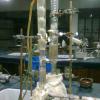Dear sir,
We are facing a regular problem of pump seal leakage and chouck problem, while transfering the material.
It is not final product, it is from reaarangement to isolation process. because of melting point 65 deg C we are flushing the line with hot water(80 deg C) before and after of the transfering the material, for one batch 7000kg.
material data: melting point 65 deg C, cp=0.55 kcal/kg k, Density=1.25gm/cc
pump data: I got from maintaince.
cap:20m3/hr , 20m head, Impeller=PP, and seal = SS316
stand by pump also having same data.
motor's=1. 1440 rpm and 5hp
2. 1440 rpm and 7.5hp
pipe line PP with FRP coating and suction and discharge of pump are 2 inch, I know suction should be greater than dischagre line, is suction and discharge line also effect the seal??
My question is which Material of construction of pump is suitable for such kind of acidic material, and also i want to know moc of pumps with different materials. please suggest me.
thanks.
Edited by karthik.kattupalyam, 18 November 2013 - 05:09 AM.

 FB
FB










